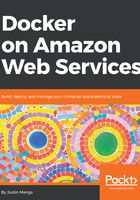
Installing application dependencies
To run the application, you need to first install any dependencies that the application requires. The sample application includes a file called requirements.txt in the src folder, which lists all required Python packages that must be installed for the application to run:
Django==2.0
django-cors-headers==2.1.0
djangorestframework==3.7.3
mysql-connector-python==8.0.11
pytz==2017.3
uwsgi==2.0.17
To install these requirements, ensure you have changed to the src folder and configure the PIP package manager to read the requirements file using the -r flag. Note that the best practice for day to day development is to install your application dependencies in a virtual environment (see https://packaging.python.org/guides/installing-using-pip-and-virtualenv/) however given we are installing the application mainly for demonstration purposes, I won't be taking this approach here:
todobackend> cd src
src> pip3 install -r requirements.txt --user
Collecting Django==2.0 (from -r requirements.txt (line 1))
...
...
Successfully installed Django-2.0 django-cors-headers-2.1.0 djangorestframework-3.7.3 mysql-connector-python-8.0.11 pytz-2017.3 uwsgi-2.0.17